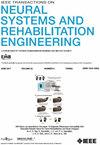Corticomuscular Coupling Alterations During Elbow Isometric Contraction Correlated With Clinical Scores: An fNIRS-sEMG Study in Stroke Survivors
IF 4.8
2区 医学
Q2 ENGINEERING, BIOMEDICAL
IEEE Transactions on Neural Systems and Rehabilitation Engineering
Pub Date : 2025-01-29
DOI:10.1109/TNSRE.2025.3535928
引用次数: 0
Abstract
The study aimed to investigate changes in corticomuscular coupling during elbow flexion and extension in stroke survivors using functional near-infrared spectroscopy (fNIRS) and surface electromyography (sEMG), and to evaluate the relationship between coupling characteristics and clinical assessment scales. This study recruited 12 stroke survivors and 12 age-matched healthy subjects, and further divided the subjects into the affected side group, healthy-side group and age-matched healthy group. They performed elbow flexion and extension tasks at 30% and 70% of the maximum voluntary contraction (MVC). The cerebral blood flow dynamics of the bilateral prefrontal cortex, motor cortex, and occipital lobe, along with sEMG signals from the biceps brachii and triceps brachii, were simultaneously recorded. At matched force levels, the fuzzy approximate entropy values of both agonist and antagonistic muscles were notably lower in the affected group compared to the healthy group (P < 0.05). The effective connectivity from the ipsilateral motor cortex to the contralateral motor cortex during elbow movements in the affected group showed a meaningful positive association with the Fugl-Meyer Assessment (FMA) scale. Additionally, the transfer entropy from the contralateral motor cortex to the agonist muscle in the affected group demonstrated a significant positive correlation with the FMA scale at 70% MVC during elbow flexion. This research identified differences in intermuscular coordination, brain network connectivity, and corticomuscular coupling between stroke survivors and healthy individuals during motor tasks and our findings suggest that it can serve as a potential quantitative marker for assessing upper limb motor function post-stroke. The relationship between these characteristics and clinical scales signifies potential quantitative assessment parameters for stroke rehabilitation, underscoring the importance of exploring corticomuscular coupling in the recovery of upper limb motor function post-stroke.求助全文
约1分钟内获得全文
求助全文
来源期刊
CiteScore
8.60
自引率
8.20%
发文量
479
审稿时长
6-12 weeks
期刊介绍:
Rehabilitative and neural aspects of biomedical engineering, including functional electrical stimulation, acoustic dynamics, human performance measurement and analysis, nerve stimulation, electromyography, motor control and stimulation; and hardware and software applications for rehabilitation engineering and assistive devices.

 求助内容:
求助内容: 应助结果提醒方式:
应助结果提醒方式:


